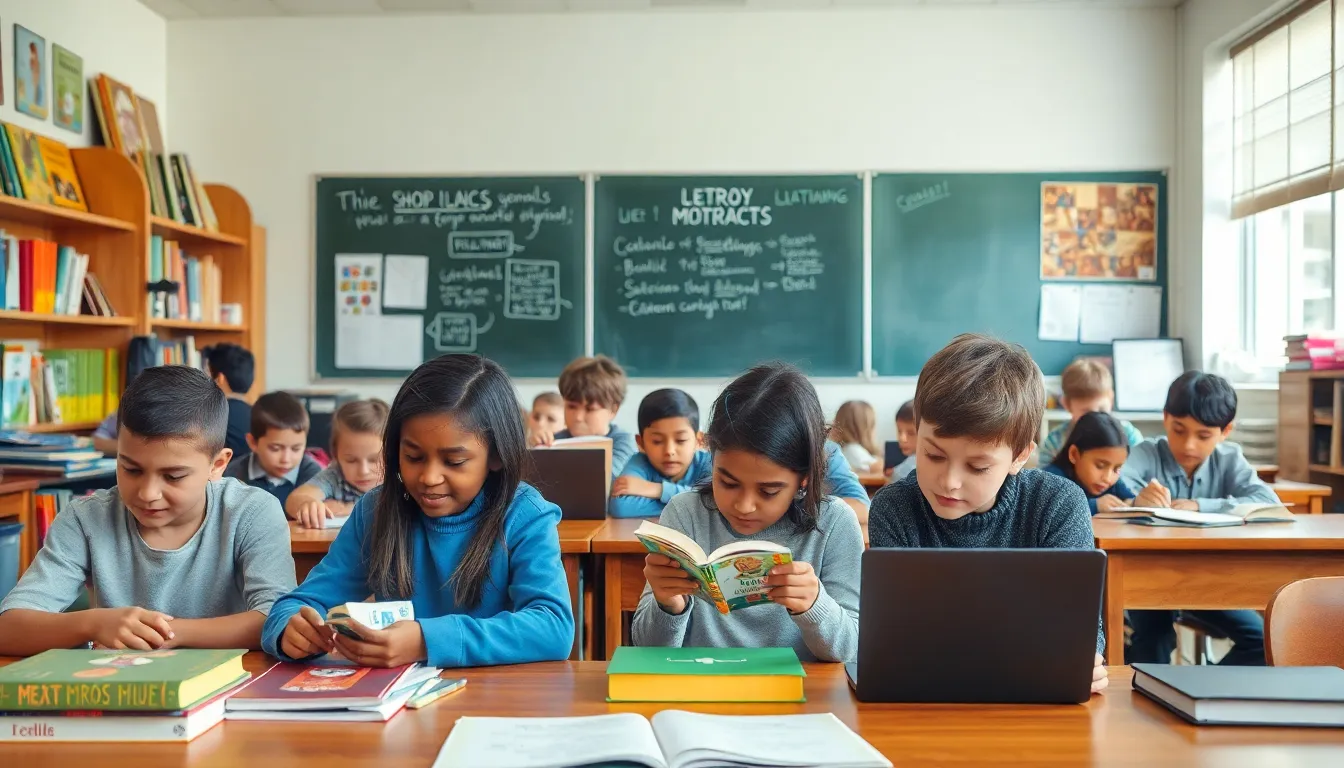In a world where emojis often replace words and TikTok reigns supreme, one might wonder: how literate are we really? Literacy statistics reveal some surprising truths about reading and writing skills across the globe. Spoiler alert: it’s not all doom and gloom, but it’s not all sunshine and rainbows either.
Imagine a world where everyone can read the fine print on their coffee cups or understand the latest bestseller without a struggle. That’s a dream worth striving for! By diving into the latest literacy statistics, readers can grasp the challenges and triumphs in this vital area of education. So grab a cup of coffee (you might need it) and let’s explore how literacy shapes lives and societies, one statistic at a time.
Table of Contents
ToggleOverview of Literacy Statistics
Global literacy rates demonstrate significant variations across different regions. In 2021, the world literacy rate stood at approximately 86.3%, with adult literacy rates at about 90% for men and 82% for women. Disparities exist as lower-income countries experience higher illiteracy rates, particularly among women and rural populations. For instance, Sub-Saharan Africa has an estimated literacy rate of 65%, illustrating the pressing need for targeted educational initiatives.
Education plays a crucial role in enhancing literacy. Each additional year of schooling raises an individual’s likelihood of literacy by 10% to 20%. Furthermore, countries that invest in education typically report higher literacy rates. In comparison, areas lacking consistent educational resources exhibit stagnation in literacy development.
According to UNESCO, 773 million young people and adults lack basic literacy skills. That number emphasizes the importance of focused policies and programs to combat illiteracy. The COVID-19 pandemic has exacerbated this issue, showing that school closures disproportionately affected marginalized populations.
Technology also influences literacy outcomes. Access to digital literacy tools can improve reading and writing skills. Approximately 44% of the global population uses the internet, which can serve as a resource for enhancing literacy. Various mobile applications target learning in enjoyable ways, making literacy education more accessible to all age groups.
Achieving universal literacy remains a global goal. For every 10 children enrolled in school, one in ten lacks the necessary skills to read and write by age 10. This stat calls for immediate actions from governments and organizations dedicated to education. Advocacy efforts and resources can bridge gaps, ensuring all individuals attain essential literacy skills, thereby fostering personal growth and societal advancement.
Global Literacy Rates

Global literacy rates reveal significant disparities across regions, emphasizing the importance of targeted educational initiatives.
Regional Differences
Sub-Saharan Africa displays the lowest literacy rates, averaging around 65%. Within this region, women and rural populations experience disproportionately high illiteracy levels. In contrast, North America boasts an adult literacy rate of approximately 99%. Asia’s diverse countries show variation, with nations like Japan achieving rates of 99%, while others face challenges. Adult literacy for men stands at about 90%, while women’s rates lag at 82%. These differences reflect cultural, economic, and infrastructural factors that influence access to education.
Trends Over Time
Literacy trends indicate gradual improvement, thanks in part to global educational efforts. From 1990 to 2021, the global literacy rate rose from 76% to 86.3%. Adult literacy for men remained stable, while women’s educational attainment is growing. Each additional year in school correlates with a 10% to 20% increase in literacy rates. However, the COVID-19 pandemic reversed some progress, hindering access to education for many. The focus now centers on recovery and adaptation, with technology playing a pivotal role in future literacy advancements.
Factors Influencing Literacy
Various factors significantly affect literacy levels globally. Economic stability and access to education play crucial roles in shaping literacy outcomes.
Economic Impact
Economic conditions heavily influence literacy rates. Wealthier nations usually exhibit higher literacy rates due to better funding for educational initiatives. In contrast, low-income regions show a direct correlation between poverty and illiteracy. Reports indicate that countries with high unemployment rate often struggle with literacy, as families prioritize immediate survival over education. Investments in education can yield significant returns, with every additional dollar spent potentially increasing literacy rates by up to 15%. Improved economic conditions can create a positive feedback loop, fostering an environment where literacy can thrive.
Educational Access
Access to quality education remains a key determinant of literacy. Rural communities and marginalized populations frequently face significant barriers to education, resulting in lower literacy rates. A large portion of the global population, roughly 258 million children, remain out of school, directly impacting their ability to read and write. Communities that prioritize educational access often see marked improvements in literacy statistics. On average, each year in school increases literacy chances by 10% to 20%. Ensuring equitable access to education enhances literacy, promoting long-term societal growth.
Literacy and Technology
Technology significantly influences literacy rates worldwide. Enhancements in digital tools lead to improved reading and writing skills, particularly in under-resourced areas.
Digital Literacy Statistics
Recent trends highlight the importance of digital literacy. In 2021, approximately 44% of the global population accessed the internet. This access facilitates learning opportunities, enabling individuals to improve their literacy skills. Reports indicated that teens and young adults exhibit higher literacy rates when engaged with online educational platforms. Data shows that students using digital resources often perform better in literacy assessments. Information literacy has also become essential, as navigating online content requires critical thinking and comprehension abilities.
The Role of Online Resources
Online resources play a vital role in modern literacy education. Various mobile applications offer engaging ways to learn reading and writing skills. Access to e-books and audiobooks makes literature more approachable for diverse audiences. Websites providing free educational materials expand learning beyond traditional classrooms. Collaborative platforms encourage peer-to-peer learning, fostering community engagement. Research indicates that students with frequent internet use show marked improvement in literacy levels. Consequently, these resources contribute significantly to bridging literacy gaps, ensuring learners gain necessary skills for success.
Literacy remains a vital component of personal and societal development. The statistics reveal significant disparities that require urgent attention. As technology continues to evolve the landscape of education, it offers new avenues for improving literacy rates globally.
Investments in education and equitable access to resources can lead to substantial improvements. By prioritizing literacy initiatives and harnessing the power of digital tools, communities can foster a more literate population. The journey toward universal literacy is ongoing, but with collective efforts, it’s possible to bridge the gaps and empower individuals through reading and writing skills.

